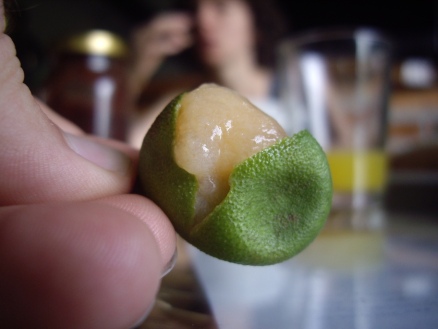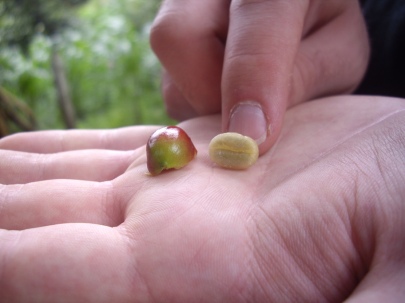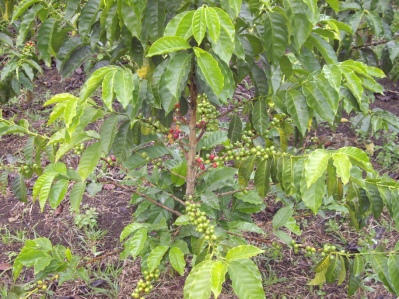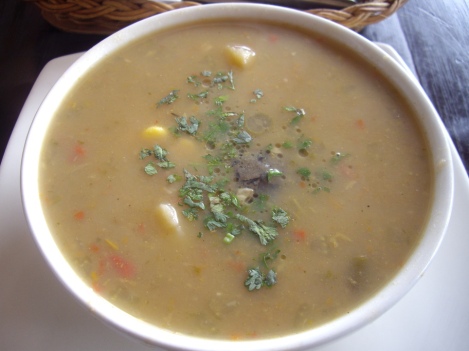Some Foods from Colombia
by infamouscookery
After a long hiatus, the “Infamous Cookery” food blog is back. About a year ago I realized that I wouldn’t be able to simultaneously write the blog and my dissertation. Now my thesis is written, edited, defended, etc. and work on the blog can resume, albeit at a slower pace than before.
About a year ago, my wife and I had an opportunity to travel Colombia with some friends from graduate school, who live in Bogotá. We saw some amazing sights and ate a number of tasty meals, some of which I’ve listed below.
Colombian Fruit:
Colombia has many delicious fruits, some of which seem to be hard to find in the US. I don’t think we’ve ever tried so many new fruits in one week.

These are granadillas. They have a relatively firm outer skin (a little like styrofoam), which you crack open (possibly against your forehead), to reveal a tasty pulp that can be eaten with a spoon.

This is a mamoncillo. After peeling off the green skin, one can chew on the (somewhat fibrous) pulp inside.

One of the interesting things about coffee beans is how much they change shape. Here is a bean freshly peeled out of a “cherry”. It’s a lot bigger than the green coffee beans one buys dry for roasting. The bean will shrink when it dries and then expand again when it’s roasted.

Guanabana (or soursop) is a really delicious fruit for making smoothies, but it is very big. The four of us barely made a dent in this basketball sized fruit.
Meals in and around San Agustin:
Travelling south from Bogotá, we drove to San Agustin, to see some pre-Columbian statues. Around San Agustin they grow a lot of sugar cane. The cane is processed into an unrefined sugar called panela, which is sold in bricks. The sugar cane juice also makes for a refreshing drink, particularly when mixed with a little lime juice.
While in San Agustin, we tried an inexpensive soup called ajiaco de pescado, which seems to be a pretty straightforward broth-potatos-corn-and-a-protein type meal.
On our way back from San Agustin, we stopped for lechona. Lechona reminds me a little bit of barbecued pork, without any tangy sauces. To prepare it, a whole pig is deboned and stuffed with rice, yellow peas, onions, and other things, and then slow roasted for many hours until the skin is crisp. The roasted pig is then sliced and served.
Along with our lechona, we ate some local cheese, which I believe was called “quesilla”. The texture was similar to fresh mozarella. I would be a very happy man if I could make cheese this tasty.
Meals in Cartagena:
We ate a number of good seafood meals while in Cartagena. The first was a fried fish, served whole with some coconut rice.
 One of these whole fishes is a substantial meal, and separating all the meat from the bones seems to be an acquired skill (which I don’t yet possess). The coconut rice is sweet and savory.
One of these whole fishes is a substantial meal, and separating all the meat from the bones seems to be an acquired skill (which I don’t yet possess). The coconut rice is sweet and savory.
 We also ate a very delicious shrimp ceviche. It’s hard to see, but beneath the guacamole is a plantain that was fried, rolled flat, and then fried again to make a wide, crispy “patacone”. I’d really like to know how to do this — when I flatten a plantain, it tends to break apart well before I can get a thin sheet like this.
We also ate a very delicious shrimp ceviche. It’s hard to see, but beneath the guacamole is a plantain that was fried, rolled flat, and then fried again to make a wide, crispy “patacone”. I’d really like to know how to do this — when I flatten a plantain, it tends to break apart well before I can get a thin sheet like this.
Finally, no trip to Colombia would be complete without a visit to Crepes and Waffles, a chain of restaurants with stylish desserts. I had some uchuva ice cream with a tasty passion fruit sauce.












